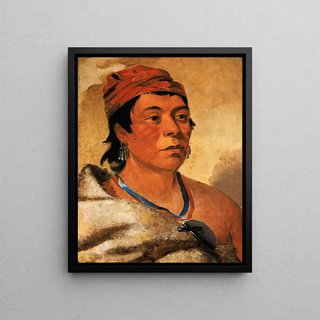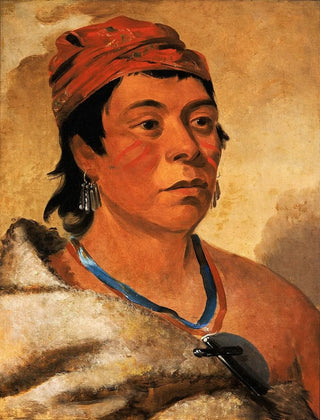Art print | Round Island, a warrior - George Catlin Source: Reproduction | Round Island, un guerrier - George Catlin


View from behind

Frame (optional)
Round Island Art print, a warrior - George Catlin – Engaging introduction
In the vibrant universe of 19th-century American art, the work "Round Island, a warrior" by George Catlin stands out for its ability to capture the essence of a disappearing culture. Catlin, a passionate advocate for indigenous peoples, dedicated his life to immortalizing their traditions and ways of life through painting. This piece, imbued with poetry and respect, evokes not only the strength and dignity of its subject but also a bygone era that is difficult to rediscover. Gazing at this art print, the viewer is immediately transported to a world where nature and man coexist in harmony, offering a window into a rich and complex past.
Style and uniqueness of the work
George Catlin's style is characterized by a realistic approach, tinged with romantic sensitivity. "Round Island, a warrior" is no exception to this rule. The artist uses vivid colors and meticulous details to bring his subject to life. The warrior, symbol of bravery and wisdom, is depicted in all his splendor, with ornaments that testify to his status and identity. The composition is carefully balanced, allowing the eye to wander through the nuances of the skin, feathers, and natural elements surrounding him. Every brushstroke seems to tell a story, every shadow evokes an emotion, making this work unique and timeless. Catlin thus manages to transcend the simple portrait to offer a true celebration of Native American culture, while inviting the viewer to reflect on the relationship between man and his environment.
The artist and his influence
George Catlin, born in 1796, is often considered the first painter to document North American indigenous peoples with such depth and respect. His passion for anthropology and history led him to travel across the continent, meeting and painting tribes many of which were then unknown to the general public. Catlin does not merely capture images; he strives to preserve a collective memory, aware of the fragility of these cultures in the face of colonial expansion. His work has had a lasting influence

Matte finish

View from behind

Frame (optional)
Round Island Art print, a warrior - George Catlin – Engaging introduction
In the vibrant universe of 19th-century American art, the work "Round Island, a warrior" by George Catlin stands out for its ability to capture the essence of a disappearing culture. Catlin, a passionate advocate for indigenous peoples, dedicated his life to immortalizing their traditions and ways of life through painting. This piece, imbued with poetry and respect, evokes not only the strength and dignity of its subject but also a bygone era that is difficult to rediscover. Gazing at this art print, the viewer is immediately transported to a world where nature and man coexist in harmony, offering a window into a rich and complex past.
Style and uniqueness of the work
George Catlin's style is characterized by a realistic approach, tinged with romantic sensitivity. "Round Island, a warrior" is no exception to this rule. The artist uses vivid colors and meticulous details to bring his subject to life. The warrior, symbol of bravery and wisdom, is depicted in all his splendor, with ornaments that testify to his status and identity. The composition is carefully balanced, allowing the eye to wander through the nuances of the skin, feathers, and natural elements surrounding him. Every brushstroke seems to tell a story, every shadow evokes an emotion, making this work unique and timeless. Catlin thus manages to transcend the simple portrait to offer a true celebration of Native American culture, while inviting the viewer to reflect on the relationship between man and his environment.
The artist and his influence
George Catlin, born in 1796, is often considered the first painter to document North American indigenous peoples with such depth and respect. His passion for anthropology and history led him to travel across the continent, meeting and painting tribes many of which were then unknown to the general public. Catlin does not merely capture images; he strives to preserve a collective memory, aware of the fragility of these cultures in the face of colonial expansion. His work has had a lasting influence






